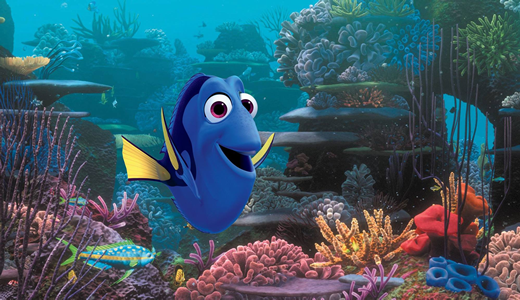Movies can make people do strange things.
And, no, I’m not talking about some of the usual suspects here. You know, teens taking up smoking (a correlation many studies have indicated) or imitating risky behavior.
Nope, I’m talking about buying tropical fish and visiting a tiny island off the southwest coast of Ireland. Why? Because movies.
Let’s start with the fish.
Back in 2003, Pixar’s Finding Nemo resulted in a huge spike in the sale of orange-and-white clownfish. How huge? The Saving Nemo Conservation Fund estimates that more than a million clownfish have been captured near reefs each year since the film came out, enough to adversely affect the entire species of lil’ Nemos.
In other words, what seems like a harmless—even affectionate!—response to a beloved animated movie wasn’t so harmless after all. Which is especially ironic given the fact that Nemo himself gets captured and ends up in a fish tank he works hard to escape from in that film.
Thirteen years later, Pixar (and parent company Disney) is preparing to release a sequel, Finding Dory (in theaters next week). That’s sparked fears that there could be a similar run on blue tangs, the kind of fish Dory is, and that the ensuing life-imitates-art fish frenzy could be even worse this time around.
“When I saw a recent article about how the movie [Finding Nemo] had adversely affected the clownfish population, despite its main moral theme, I was dismayed. Then I learned that with Finding Dory the risk is even greater because Blue Tang Fish can’t be bred in captivity, I was super worried,” Kelsey Bourgeois told Fox News.
That prompted her to start a Care2Petition asking Disney to run a PSA before the movie addressing the importance of protecting this pretty blue species of tropical fish.
“With the new film Finding Dory coming out, researchers are seriously panicking. So each and every ‘Dory’ Blue Tang Fish that is adopted will have been plucked from its home in the ocean. Individual viewers may not know that Blue Tang can’t be bred in captivity. But Disney does, so they should educate viewers to protect the fish.”
No word yet on whether Disney will honor Bourgeois’ petition. But I wouldn’t be a bit surprised if it did. After all, I’m pretty sure the folks at Disney and Pixar don’t want to have responsibility for a blue tang apocalypse pinned on them.
It turns out Disney’s involved in that other story, too, the one in Ireland.
You know that beautiful, ancient-looking island Rey ends up on near the end of Star Wars: The Force Awakens? It’s real, not just an elaborate set or CGI trickery. The island’s name is Skellig Michael, and it was the home to an isolated group of Christian monks for some 600 years, starting somewhere around the sixth-century AD. The remnants of the monastery are still there, and the monks’ handiwork is pretty much just as it was when they abandoned the strikingly picturesque island sometime in the 12th century. Which is to say, it looks ancient because it is ancient.
So ancient, in fact, that too much traffic to the island isn’t necessarily a good thing. After all, the sixth-century monks who built the monastery there—including the rocky 600-step stairway featured in the film—didn’t construct it with legions of 21st-century Star Wars fans in mind.
Local authorities have capped the number of visitors at just 180 a day, somewhat anxious that more traffic than that might begin to cause excessive wear and tear on the island, which has been declared a UNESCO World Heritage Site. Not surprisingly, the number of visitors coming to the island since The Force Awakens’ release has shot up—so much so that the available slots for visiting Skellig Michael are completely booked for the island’s short May-to-September tourist season this year.
In addition, there’s also an undercurrent of frustration among some locals that an island with historic cultural significance dating back centuries may now become better associated with a fictional story from a sci-fi galaxy far, far away.
In the end, I suspect that the blue tang and clownfish populations will ultimately survive the next movie featuring them. And I imagine that Irish authorities will figure out a way to protect mystical, monastic Skellig Michael too.
But I think both of these stories demonstrate the amazing ways that a compelling fictional tale can work its way into our hearts so deeply that we feel compelled to connect with it in the real world. And sometimes even an innocent embrace of something we’ve seen on the big screen can have unintended consequences.






Recent Comments